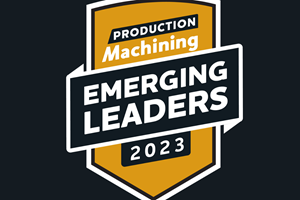Technology’s Effect on Young Manufacturers
It might be easy to see the productivity advantages created by IIoT tools, but don’t overlook the impact they can have on workforce development.
As the world becomes a more digital place, we cannot forget about the human connection.
— Adam Neumann
Let’s take a trip back in time. Imagine a scene 40 years ago—I’m in my mid-teens, flipping through shelves of vinyl albums at the local record store. Many of you may have a similar memory of yourself, perhaps in a slightly different timeframe. Music was big then, as it is now. Not everyone loves music the way I do, so I’m sure I had a larger than average collection of records, but almost everyone I knew had at least some. We liked to listen to music; we liked to talk about it. But attaining the songs we wanted to hear was often a challenge.
I had already lived through the days of sitting in front of my hand-held transistor radio with a cassette recorder, waiting for one of my favorite songs to come on the air so I could make a copy. Wow, such high fidelity! The popularity of 8-track tapes had mostly faded at this point without being able to supplant the mighty record album. Prerecorded cassette tapes were beginning to gain traction, but we’d later learn that they also did not have enough allure to hang on long-term; their portability was their only advantage. Even today the classic sound of the record on the turntable is a draw for some, who prefer the crackling of a needle scraping the surface of a flawed disk over the pure sound of digital recordings. But those who hang on to this old technology mostly do so for nostalgia’s sake and tend to be baby boomers or the oldest of the Gen-Xers (like me).
Back in the day, we seemed to have a much greater appreciation of the music of the time, and I believe this bond was directly related to the effort it took to hear our favorites. We didn’t easily grow tired of songs—many of which have stood the test of time, receiving regular airplay still today—as quickly as today’s listeners do of modern music.
The music industry now seems different. I will withhold my judgement of the quality of music, as I understand everyone is entitled to his or her own tastes. But will today’s hits be considered classics and still be heard 20 to 30 years from now? I believe they will be long forgotten. Music services and electronic downloads provide such convenient access to songs that they’ve diminished their perceived value. The disposable culture that we’ve created has severely affected product longevity.
The digital age is increasing the pace of everything around us, but this movement brings with it favorable consequences as well. Yes, music is coming and going faster than ever, but communication is also easier, information is more accessible for learning, and data collection and analysis is at our fingertips. While many of these trends may create culture shock for some people in older generations, it’s been a natural progression for our youth.
This transition has hit the machine tool industry with equal impact. The Industrial Internet of Things (IIoT) is shaping the future of manufacturing, and by its nature is helping to capture the interest of younger manufacturing professionals. This shift is vital to the industry’s ongoing growth.
In my time writing for Production Machining, I’ve seen the rise and increased development of tools that implement digital capabilities for data collection and transfer. Machine controls have become far more advanced in the ways they interface with the operator, both for ease of use and functionality. Engineers are developing new ways all the time to capitalize on the communication advantages that the Internet brings.
While these tools are gaining steam because of their influence on quality and productivity, a side effect that perhaps was unexpected is the draw it creates for the younger workforce. These “kids” love this stuff, and they’re good at it!
We regularly address the issues surrounding workforce development, but incorporating digital technology into everyday operations is a great step toward capturing the interests of the millennial and “Generation Z” labor pools. These people were raised on computers, video games and smart phones. The more this technology is incorporated into the shopfloor environment, the more attractive the related jobs become.
Related Content
Recognizing Signs of a Degrading Workplace Culture
Is your machine shop missing key “culture elements?” Here are ways to identify if your organization is heading in the right or wrong direction in terms of establishing a healthy company culture.
Read MoreApplying a Healthy Approach to Employee Investment
Service Center Metals’ on-site health center offers its employees and their families free same-day health care and, in return, the employer is gaining many benefits including a healthier workforce and attracting potential employees.
Read MoreCNC Machine Shop Employment Positions to Consider Beyond Machine Operators
Many machine shops have open machine operator positions to fill. But does it make sense for shops to also seek automation engineers, IT managers and assembly personnel?
Read More2023 Emerging Leaders Strengthen Their Staffs, Solve Problems
Superb critical thinking, top-notch leadership skills and a passion for building a strong team are a few of the common traits held by this year’s five Production Machining Emerging Leader award winners.
Read MoreRead Next
Being Social is Networking
Networking involves putting oneself in a position to make connections and making an effort to communicate. It’s a social thing, regardless of whether the Internet is a part of it.
Read MoreEMO 2019 Observations from the Barber’s Chair
Business trips can be disruptive to the routine, but an opportunity to see a show like EMO 2019 should not be missed. Smart technologies are driving tomorrow’s production.
Read MoreWhen You Know it’s Right
Unfortunately, not all major decisions are this easy. This life-changing choice, though, is a no-brainer.
Read More













.jpg;maxWidth=300;quality=90)










